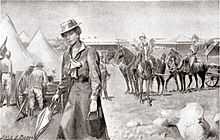Sarah Wilson (war correspondent)

Lady Sarah Wilson, RRC (1865 – 22 October 1929), born Lady Sarah Isabella Augusta Spencer-Churchill, became the first woman war correspondent in 1899, when she was recruited by Alfred Harmsworth to cover the Siege of Mafeking for the Daily Mail during the Boer War.
Family
Lady Sarah Spencer-Churchill was the youngest of the eleven children of John Spencer-Churchill, 7th Duke of Marlborough (1822–1883), and his wife, Lady Frances Anne Emily Vane (1822–1899), daughter of the 3rd Marquess of Londonderry. Her eldest brother was George Charles Spencer-Churchill, 8th Duke of Marlborough (1844–1892), and another brother was Lord Randolph Churchill (1849–1895), father of the Prime Minister Winston Churchill (1874–1965), who also worked as a war correspondent during the Boer War, for The Morning Post. Anne, Duchess of Roxburghe (1854–1923) was her elder sister.
In 1891, she married Lieutenant-Colonel Gordon Chesney Wilson MVO (1865–1914), of the Royal Horse Guards, son of Sir Samuel Wilson, MP. They had one son.
Siege of Mafeking correspondent
The Daily Mail newspaper recruited Lady Sarah after one of its correspondents, Ralph Hellawell, was arrested by the Boers as he tried to get out of the besieged town of Mafeking to send his dispatch. She was in the right place at the right time to step into the journalistic breach, having moved to Mafeking with her husband, Lt.-Col. Gordon Chesney Wilson, at the start of the war, where he was aide-de-camp to Col. Robert Baden-Powell, the commanding officer at Mafeking. Baden-Powell asked her to leave Mafeking for her own safety after the Boers threatened to storm the British garrison. This she duly did, and set off on a madcap adventure in the company of her maid, travelling through the South African countryside until she was finally captured by the enemy and returned to the town in exchange for a horse thief being held there.
When she re-entered Mafeking, she found it had not been attacked as predicted. Instead, over four miles of trenches had been dug and 800 bomb shelters built to protect residents from the constant shelling of the town.
Although untrained as a reporter, Wilson soon gained a huge following among Mail readers back in England, who appreciated her matter-of-fact writing style.
On 26 March 1900, she wrote:
The Boers have been extremely active during the last few days. Yesterday we were heavily shelled and suffered eight casualties … Corporal Ironside had his thigh smashed the day before, and Private Webbe, of the Cape Police, had his head blown off in the brickfields trenches.
But although death and destruction surrounded her, the Mail’s fledgling war correspondent preferred not to dwell too much on the horrors of the siege. She described cycling events held on Sundays and the town’s celebration of Colonel Baden-Powell’s birthday, which was declared a holiday.
Despite these cheery events, dwindling food supplies became a constant theme in the stories she sent back to the Mail and the situation seemed hopeless when the garrison was hit by an outbreak of malarial typhoid. In this weakened state the Boers managed to penetrate the outskirts of the town, but the British stood firm and repelled the assault.
The siege finally ended after 217 days when the Royal Horse and Canadian Artillery galloped into Mafeking on 17 May 1900. Only a few people standing in a dusty road, singing "Rule, Britannia!", were there to greet their saviours. But in London it was a different scene as more than 20,000 people turned out in the streets to celebrate the relief of Mafeking (which created the verb to maffick, for extravagant and public celebrations).
Wilson's dispatches and the desperate circumstances of the small outpost made it a symbol of the "bulldog spirit" (the bulldog being a national symbol of the UK, due to its tenacity) and there was much rejoicing at this triumph over adversity.
Later life
In May 1901, Wilson was invested as a Dame of Grace of The Most Venerable Order of the Hospital of Saint John of Jerusalem (D.G.St.J.),[1] and in December the same year King Edward VII personally conferred on her the decoration of the Royal Red Cross (RRC) for her services in Mafeking.[2]
References
- ↑ The London Gazette: no. 27313. p. 3282. 14 May 1901.
- ↑ "Court circular" The Times (London). Wednesday, 18 December 1901. (36641), p. 6.
- S. J. Taylor (1996). The Great Outsiders: Northcliffe, Rothermere and the Daily Mail. Weidenfeld & Nicolson. ISBN 0-7538-0455-7.
External links
- Works by Sarah Wilson at Project Gutenberg
- Works by or about Sarah Isabella Augusta Wilson at Internet Archive
- Works by or about Lady Sarah Wilson at Internet Archive
- Works by Sarah Wilson at LibriVox (public domain audiobooks)

- Portrait of Lady Sarah Isabella Augusta Wilson (1865-1929), daughter of 7th Duke of Marlborough at the National Portrait Gallery
- South African Memories
|